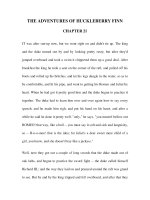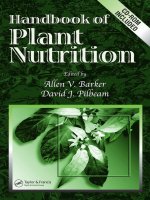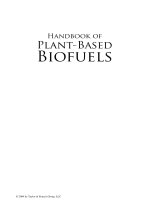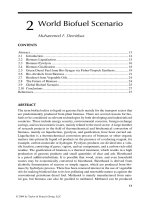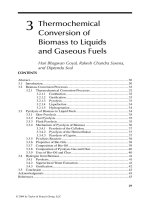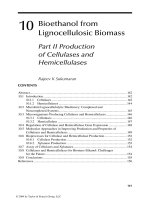Handbook of Plant Nutrition - chapter 21 doc
Bạn đang xem bản rút gọn của tài liệu. Xem và tải ngay bản đầy đủ của tài liệu tại đây (275.08 KB, 12 trang )
21
Vanadium
David J. Pilbeam and Khaled Drihem
University of Leeds, Leeds, United Kingdom
CONTENTS
21.1 Historical 585
21.2 Growth Effects 586
21.2.1 Growth Stimulation 586
21.2.2 Toxicity 587
21.3 Metabolism 588
21.4 Vanadium in Plant Species 589
Acknowledgment 594
References 594
21.1 HISTORICAL
The transition element vanadium exists mostly in the ϩ3, ϩ4, and ϩ5 oxidation states (Table 21.1),
with the ϩ4 and ϩ5 states predominating under oxidizing conditions in the normal soil acidity of
below pH 8 (1,2). Vanadium, with many other heavy metals, is released by anthropogenic activity,
and its concentration has been steadily increasing in the environment. A study on peat dating back
12,370 years from a bog in Switzerland indicated a large increase in inputs of vanadium since the
industrial revolution (3). Analysis of herbarium specimens of 24 species of vascular plants and 3
bryophytes collected over many years in Spain has shown a large increase in leaf vanadium con-
centrations, particularly since the 1960s (4).
In soils, the main source of vanadium is from the burning of coal, and the subsequent addition
of fly ash and bottom ash. In 1988, this ash contributed 11 to 67 ϫ 10
6
kg V yr
Ϫ1
to soils, 25% of
the total vanadium deposited (5). Agricultural and food wastes contributed 3 to 22 ϫ 10
6
kg yr
Ϫ1
,
and atmospheric fallout added 3.2 to 21 ϫ 10
6
kg yr
Ϫ1
.
585
TABLE 21.1
Oxidation States of Some Important Species of Vanadium
Species Formula Oxidation State
Vanadous V
2ϩ
ϩ2
Vanadic V
3ϩ
ϩ3
Vanadyl VO
2ϩ
ϩ4
Pervanadyl VO
3ϩ
; V(OH)
4
ϩ
ϩ5
Metavanadate VO
3
Ϫ
ϩ5
CRC_DK2972_Ch021.qxd 7/1/2006 7:33 AM Page 585
Total atmospheric fallout in a typical year in recent times (1983) resulted mainly from the burn-
ing of oil in electricity generation (estimated to be 6960 to 52,200 ϫ 10
3
kg ) and from industrial
and domestic combustion of oil (30,150 to 141,860ϫ 10
3
kg ) (5). Of the 15 heavy metals consid-
ered in that study, vanadium was the highest to be emitted during oil combustion (5), and its pres-
ence is often taken as an indicator of oil pollution (4).
In a study of microelements in the needles of white fir (Abies alba Mill.) in the Carpathian
mountains of Eastern Europe, vanadium was found in high concentrations in the vicinity of ferrous
metal plants (6), and it is emitted into the atmosphere during the production of copper, nickel, iron,
and steel, and during the incineration of sewage sludge (5). With the discontinuation of sewage
sludge incineration in many countries, it might be expected that direct addition of vanadium to soils
in sewage sludge could increase worldwide.
The natural vanadium, occurring at approximately 110 to 150mg kg
Ϫ1
(1,7) in the crust of the
Earth, is found particularly in roscoelite (KV
3
Si
3
O
10
(OH)
2
), vanadinite (Pb
5
(VO
4
)
3
Cl), and patronite
(VS
4
) (1). During weathering of these rocks, vanadium is oxidized to the vanadate ion, which because
of its solubility in water across a range of pH values makes vanadium readily available to plants.
However, in practice, vanadium is not very mobile in soil, and in a study on a loamy sand, only a very
small proportion of vanadium added to the top 7.5cm of soil migrated down within 18 or 30 months;
81% remained in the top of the soil where it was added (2). The amount of vanadium that was removed
by HCl–H
2
SO
4
extraction of the top 7.5cm of soil decreased by 81% during 18 months; hence, vana-
dium must have been transformed to an immobile form with time. Vanadium is known to adsorb to
iron and aluminum oxides in the clay fraction (2). Some vanadium may be precipitated as Fe(VO
3
)
2
,
and some may be immobilized by anion exchange (2).
The correlation is good between soil organic matter content and the oxidizable (immobile) frac-
tion of vanadium (8). Insoluble humic acid is known to reduce mobile metavanadate (VO
3
Ϫ
) anions
to vanadyl (VO
2
ϩ
) cations, which probably bind to the humic acid by cation exchange (1). In an
industrial area of Poland, most of the vanadium was bound to soil organic matter in a recent study
of a soil that was rich in the element. The next largest fraction was the residual fraction followed,
in order, by a fraction bound to iron-manganese oxides, a fraction in exchangeable form, and finally
a fraction bound to carbonates in amounts too small to measure. The much lower amounts of vana-
dium in soil from an agricultural area occurred in the order of exchangeable fraction, residual frac-
tion, the fraction bound to iron-manganese oxides, and the fraction bound to organic matter, with
the fraction bound to carbonates being again too small to measure (9).
Uptake and accumulation are influenced by soil type, as soil composition affects the availabil-
ity of vanadium. Vanadium generally is accumulated in plants in very small amounts in comparison
to the total vanadium content of the soil (1). In a comparison of soybeans (Glycine max Merr.)
grown in a fluvo-aquic soil and an Oxisol, an increase in shoot vanadium concentration occurred
when concentrations of more than 30 mg V kg
Ϫ1
were added to the fluvo-aquic soil, but no increase
occurred at concentrations of up to 75 mg V kg
Ϫ1
added to the Oxisol (10). Plant growth was inhib-
ited when the concentration of vanadium supplied exceeded 30 mg kg
Ϫ1
in the fluvo-aquic soil but
was not inhibited in the Oxisol. In a study on bush bean (Phaseolus vulgaris L.), the accumulation
of vanadium from a loamy sand was more than double the accumulation of cadmium and more than
300 times the accumulation of thallium (2). Concentrations of vanadium in plants are typically 0.27
to 4.2 mg kg
Ϫ1
dry weight (11). At low rates of supply, vanadium appears to stimulate plant growth,
but at higher rates of supply it appears to be toxic to many plants (7).
21.2 GROWTH EFFECTS
21.2.1 G
ROWTH STIMULATION
Vanadium was considered to be a micronutrient for the green alga Scenedesmus obliquus Kützing
during experiments in which impure iron salts were being used to assess the iron requirement of the
586 Handbook of Plant Nutrition
CRC_DK2972_Ch021.qxd 7/1/2006 7:33 AM Page 586
species (12). It was difficult to confirm a similar requirement in higher plants (13). First, it is
difficult to eliminate vanadium entirely from nutrient cultures (13). Also, although vanadate is a
well-known inhibitor of plasma membrane proton-pumping ATPases, trace concentrations have
been reported to benefit plant growth. In an experiment on sand-grown corn (Zea mays L.), a sup-
ply of vanadium increased grain yield, probably because leaf area was increased but also possibly
due to physiological effects (14). Supply of vanadium to tomato (Lycopersicon esculentum Mill.) at
0.25 mg L
Ϫ1
of nutrient solution gave greater plant height, more leaves, more flowers, and greater
plant mass than supplying no vanadium (15).
Hewitt, working with data from Welch and Huffman (16), calculated that the concentrations of
vanadium in tomato plant cells are less than 1% of the concentration of vanadium in vanadium-
deficient Chlorella cells, suggesting that vanadium is not an essential element for the growth
of higher plants (13). In the paper on which Hewitt’s calculations were based, lettuce (Lactuca
sativa L.) and tomato plants were grown to maturity in nutrient solutions containing less than
0.04 mg V L
Ϫ1
and with tissue concentrations of Ͻ2 to 18 mg V kg
Ϫ1
dry weight (16). Plant growth
in this low concentration of vanadium was comparable to that in nutrient solutions containing 50mg
V L
Ϫ1
, with tissue concentrations of 117 to 419 mg kg
Ϫ1
dry weight, whereas it might have been
expected that the low concentration of vanadium should have had a beneficial effect on growth.
However, iron was supplied as the citrate salt, and in work on Chlorella pyrenoidosa, vanadium
stimulated growth when iron was supplied as FeCl
3
but had only negligible effect when iron was
supplied as citrate or iron EDTA (17). Therefore, part of its requirement as an essential element in
algae, at least, is as a replacement for unavailable iron, and supply of iron in a readily available form
removes this requirement. If vanadium is a beneficial element for higher plants it may be so only
when iron or other metals are limiting.
21.2.2 TOXICITY
If some doubt exists about the role of vanadium as a beneficial element, there is no doubt that at
high rates of supply (10 to 20 mg L
Ϫ1
) it is harmful to plants (12). Sorghum (Sorghum bicolor
Moench.) seedlings supplied with vanadium as ammonium metavanadate at 1, 10, or 100 mg L
Ϫ1
in
nutrient solutions showed no toxic effects in the 1mg L
Ϫ1
solution, but showed a noticeable red-
dening of the lower stems, and later the leaf tips, in the 10mg L
Ϫ1
or higher solution (7). In an
experiment on bush beans planted 15 months after application of 5.6 kg VOSO
4
H
2
O ha
Ϫ1
on the
surface and harvested 3 months later, growth of shoots and roots was significantly less than in unfer-
tilized plants (2).
In the experiments in which soybeans were grown in a fluvo-aquic soil or in an Oxisol, plant
growth was inhibited when the concentration of vanadium supplied exceeded 30 mg kg
Ϫ1
in the
fluvo-aquic soil, a rate of supply that gave a shoot concentration of approximately 1 mg V kg
Ϫ1
dry matter (10). With a supply of 75 mg V kg
Ϫ1
soil, the shoot concentration was approximately
4 mg kg
Ϫ1
dry matter, and plant growth was even more depressed than with the lower supply of
vanadium (10).
One of the reasons for the harmful effects of vanadium is that it induces iron deficiency.
Noticeably decreased concentrations of iron were measured in leaves of a manganese-sensitive bush
bean cultivar supplied with vanadate (18). Cereals, strawberries (Fragaria X ananassa Duchesne),
and flax (Linum usitatissimum L.) are noted as being very sensitive species (19). Wheat (Triticum
aestivum L.) and barley (Hordeum vulgare L.) are more sensitive than rice (Oryza sativa L.) or soy-
bean (20). In addition to causing chlorosis from iron deficiency, vanadium has been shown to lower
the concentration of iron in roots of soybeans (21) and to lower root concentrations of magnesium
and potassium in soybean (22,23) and lettuce (23). Vanadium also decreased root and hypocotyl
accumulation of molybdenum in white mustard (Sinapis alba L.) (25) and decreased calcium con-
centrations in leaves of soybean (23,24). Root and hypocotyl concentrations of manganese, copper,
and nickel were increased in Sinapis alba (25), and leaf concentration of manganese was increased
Vanadium 587
CRC_DK2972_Ch021.qxd 7/1/2006 7:33 AM Page 587
to toxic levels in bush bean (18). Some evidence indicates that vanadium may increase aluminum
concentrations in soybeans (22).
In a field experiment with soybean, seed yields decreased with an increase in vanadium con-
centration in the soil, or more precisely with an increase in the V:(VϩP) ratio (26). Seed yield
decreased by approximately 20% as the resin-extractable V:(VϩP) ratio increased to 0.15 mol
mol
Ϫ1
(26), although a decrease also occurred in relation to vanadium alone (27). The negative rela-
tionship between vanadium and phosphorus is not surprising given that the inhibition of ATPases
by vanadate is brought about by competitive inhibition of phosphate-binding on the enzymes.
If the harmful effects of vanadium become more important with time as anthropogenic sources
increase, it would be helpful to be able to alleviate them. The effects of vanadium in the soil can be
reduced by adding a chelating agent, such as γ-irradiated chitosan, to the soil (20). Furthermore, it
might be expected that since vanadium induces iron deficiency in plants, increased iron supply
might alleviate vanadium toxicity, and this effect has been shown to be the case (28).
21.3 METABOLISM
Vanadium has been shown to enhance chlorophyll formation and iron metabolism of tomato plants
and to enhance the Hill reaction of isolated chloroplasts (15). Corn plants that had higher grain yield
with a supply of vanadium in sand culture had increased concentrations of chlorophyll a and chloro-
phyll b (14). Supply of vanadium increased the synthesis of chlorophyll through enhanced synthesis
of the porphyrin precursor δ-aminolevulinic acid in the green alga Chlorella pyrenoidosa Chick. (29),
although the pH optimum for the enhancement of chlorophyll synthesis by vanadium was slightly
different from the pH optimum for enhancement of algal cell growth (30). The substitution of vana-
dium for iron in green algae highlights the involvement of both ions in chlorophyll synthesis.
No clear evidence is available for the role of vanadium in chlorophyll synthesis in higher plants,
but iron deficiency gives rise to lower amounts of chlorophyll per chloroplast (31), and the require-
ment for iron in chlorophyll synthesis has been narrowed down to a specific step (32) rather than to
secondary effects. The requirement for iron is clear, and vanadium may possibly influence chloro-
phyll synthesis only through an effect on iron metabolism. At one stage it was proposed that green
algae may have a pathway of synthesis of δ-aminolevulinic acid that is vanadium-dependent but
differs from the pathway in higher plants (13); however, such a pathway has not been identified. In
recent years, genes coding for the enzymes involved in this synthesis have been identified in higher
plants and in algae, so differences in the pathway, if they exist, appear to be at the level of control
rather than in the pathway itself. It is possible that vanadium is an essential cofactor for one of the
enzymes of chlorophyll biosynthesis in green algae, but in higher plants this role is normally taken
on by another metal for which vanadium can substitute.
Vanadate (but not vanadyl) promoted the evolution of oxygen from intact cells of Chlorella
fusca at the same concentrations that gave maximum promotion of algal growth (1 to 2µM)
(33). Vanadium was thought to work in the chain of electron transport between photosystems
2 and 1 by virtue of the ability of the vanadium to change reversibly between its tetravalent and
pentavalent states (33). Vanadium also increased photosystem 1 activity (but not photosystem
2 activity) in isolated chloroplasts of spinach (Spinacia oleracea L.), with an optimum at approx-
imately 20 µM V (33).
Corn plants that showed enhanced grain yield with supply of vanadium had more nitrogen,
phosphorus, potassium, calcium, and magnesium in the leaves, although high concentrations of
vanadium decreased the concentrations of these elements (14). Vanadium was shown to increase
foliar concentrations of calcium and iron in lettuce, although in these plants, yield was actually
depressed by the vanadium supplied (23).
The presence of vanadium certainly affects the metabolism of plants. Addition of vanadium at
1mg L
Ϫ1
to solution reduced nicotine concentrations in tobacco (Nicotiana tabacum L.) by 25%
588 Handbook of Plant Nutrition
CRC_DK2972_Ch021.qxd 7/1/2006 7:33 AM Page 588
(34). In lupin (Lupinus polyphyllus Lindl.), a negative correlation between alkaloid and vanadium
concentrations in the leaves has been observed (35).
Given the inhibitory effects of vanadate on plasma membrane ATPases, it is not surprising that
vanadium should affect metabolism. Changes in concentrations of other ions in plants supplied with
vanadium could in part be due to the effects on proton-pumping APTases, although uptake of phos-
phate into isolated corn root tips was inhibited less than the activity of ATPase in the tips at the same
amount of sodium vanadate supplied (36). Nevertheless, heavy exposure of these enzymes to vana-
dium might be expected to stop plant transport completely. Some evidence indicates that vanadium
may also inhibit the absorption of water (37).
Absorption of vanadium appears to be a passive process as it is a linear function of external vana-
dium concentration and is not affected by putting excised roots into anaerobic conditions (38).
Absorption is highly pH-dependent, being fastest at pH 4 and dropping to a very slow rate by pH 10,
although being relatively constant between pH 5 and 8 (38). This effect of pH on absorption appears
to be due to the ionic form in which vanadium is present, with VO
2
ϩ
predominating at pH 4, HVO
3
predominating between pH 4 and 5, VO
3
Ϫ
predominating between pH 5 and 8, and HVO
4
2Ϫ
pre-
dominating at pH 9 to 10 (38). The VO
2
ϩ
form that predominates in acid soil is taken up by plants
far more readily than the other forms that predominate in neutral and alkaline soils (11).
Absorption of vanadium appears to occur at the expense of calcium uptake, there being a linear
decrease in calcium accumulation into sorghum cultivars with log concentration of vanadate sup-
plied (39). This result is probably due to an effect on calcium channels that more than compensates
for the inhibition by vanadate of the H
ϩ
-translocating ATPase responsible for calcium flux. The
presence of calcium is required for absorption of vanadium, and this effect, together with the fact
that vanadium concentrates in the roots at up to twice the concentration in the external medium,
indicates that the passive absorption cannot be purely by diffusion. A concentration gradient from
outside to inside the root could be maintained by the vanadium changing form inside the root, with
up to 10% of VO
3
Ϫ
taken up being reduced to VO
2
ϩ
(40), or it could be chelated (38).
Indeed, various complexes of vanadium have been detected in plants. At low rates of vanadium
supply, plants form low-molecular-weight complexes thought to be vanadyl amino compounds, and
at high rates of supply, plants form high molecular weight complexes, probably vanadyl cellulose
compounds (41). It seems that following absorption, vanadium is partially immobilized on the root
cell walls. It then develops soluble complexes outside the plasmalemma and finally is absorbed into
the vacuoles within the cells (41). Concentrations in roots are usually higher than in leaves.
Calcium seems to accumulate in roots along with vanadium. In soybeans supplied with vana-
dium, both elements were concentrated in the roots, and very high concentrations of calcium have
been detected in the roots of vanadium-accumulating species. Perhaps, calcium may work to
detoxify the vanadium (7,24). It is possible that the vanadium occurs as insoluble calcium vana-
date (1). This action may be only a partially successful detoxification as it has been suggested that
the accumulation of calcium might give rise to the imbalance in other cations associated with vana-
dium toxicity (24).
There does not appear to be much inhibition of absorption of vanadium by molybdate, borate,
chloride, selenate, chromate, or nitrate (38). However, in Sinapis alba nickel, manganese, and cop-
per inhibited the accumulation of vanadium in roots and hypocotyls, whereas molybdate decreased
its accumulation in the hypocotyls and enhanced its accumulation in the roots (25).
21.4 VANADIUM IN PLANT SPECIES
In general, lower plants contain more vanadium than seed-bearing plants, and older parts contain
more than younger parts (7). Despite this overall trend, some angiosperms seem to be accumulator
plants (Table 21.2). In an experiment where sorghum seedlings showed noticeable harmful effects
Vanadium 589
CRC_DK2972_Ch021.qxd 7/1/2006 7:33 AM Page 589
590 Handbook of Plant Nutrition
TABLE 21.2
A List of Concentrations of Vanadium in Various Plant Species
Plant Type of Concentration in Dry
Plant Species Part Culture Matter (mg kg
ϪϪ
1
) Reference Comments
Allium macropetalum Root Wild 133 7 Accumulator species
Rydb. (onion)
Anethum graveolens Shoot Field 0.84 44
L. (dill)
Astragalus confertiflorus Shoot Wild 144 7 Accumulator species
Gray (yellow milkvetch)
Astragalus preussi Shoot Wild 67 7 Accumulator species
A. Gray (milkvetch)
Avena sativa L. (oat) Seed Nutrient 0.055 45 No added V
solution 0.151 0.25 mg V L
Ϫ1
Brassica napus L. Seed Nutrient 0.018 45 No added V
(rape) solution 0.132 0.25 mg V L
Ϫ1
Brassica oleracea var. Florets Field 1.09 ϫ10
Ϫ3
44
botrytis L. (cauliflower)
Carthamus tinctorius L. Seed Nutrient 0.019–0.021 45 No added V
(safflower) solution 0.173–0.184 0.25 mg V L
Ϫ1
Castilleja angustifolia Shoot Wild 22 7 Accumulator species
G. Don.
(desert paintbrush)
Chrysothamnus Shoot Wild 37 7 Accumulator species
viscidiflorus Nutt.
(rabbitbrush)
Conifers (unidentified Leaves Soil 0.69 7
species)
Cowania mexicana Shoot Wild 7.4 7 Accumulator species
D.Don var.
stansburiana
(cliff rose)
Cucumis sativus L. Fruit Field or 5.6 ϫ10
Ϫ2
44
(cucumber) glasshouse
Deciduous shrubs Leaves Soil 2.7 7
(unidentified species)
Deciduous trees Leaves Soil 1.65 7
(unidentified species)
Equisetum sp. Soil 2.4 7
(horsetail)
Eriogonum inflatum Shoot Wild 15 7 Accumulator species
Torr. & Frém.
(desert trumpet)
Ferns (unidentified Fronds Soil 1.28 7
species)
Forbs (unidentified Leaves Soil 1.20 7
species excluding
legumes)
Fragaria X ananassa Fruit Field 3.1 ϫ10
Ϫ2
44
Duchesne (strawberry)
Fragaria vesca L. Fruit Wild 4.1 ϫ10
Ϫ2
44
(wild strawberry)
Continued
CRC_DK2972_Ch021.qxd 7/1/2006 7:33 AM Page 590
Vanadium 591
TABLE 21.2 (
Continued
)
Plant Type of Concentration in Dry
Plant Species Part Culture Matter (mg kg
ϪϪ
1
) Reference Comments
Glycine max Merr. Shoot Nutrient 2.3 28 No V, no Fe, then
(soybean) solution low Feϩ V
3.9 V, no Fe, then low Fe
0.7 No V, no Fe, then
high Fe ϩV
0.8 High Fe ϩV
Root 170 No V, no Fe, then
low Feϩ V
129 V, no Fe, then low Fe
41 No V, no Fe, then
high Fe ϩV
115 High Fe ϩ V
Pods Soil in 27/29 24 Control/plus extra
rhizotron metals (including V)
(Control is no metals
added)
Upper 22/33 Control/plus extra
leaves metals (including V)
(Control is no metals
added)
Lower 20/30 Control/plus extra
leaves metals (including V)
(Control is no metals
added)
Roots 28/77 Control/plus extra
metals (including V)
(Control is no metals
added)
Upper Nutrient 0/0 24 3.0/6.0 mg V L
Ϫ1
leaves solution
Lower 1/1 3.0/6.0mg V L
Ϫ1
leaves
Roots 18/20 3.0/6.0 mg V L
Ϫ1
Shoot Soil 1.0 10 30 mg V kg
Ϫ1
fluvo-aquic soil
4.0 75mg V kg
Ϫ1
fluvo-aquic soil
0.5 75 mg V kg
Ϫ1
Oxisol
Youngest Vermiculite 53.6 21 104-day-old plants,
leaf and nutrient 100 µmol V L
Ϫ1
Oldest solution 45.6 104-day-old plants,
leaf 100 µmol V L
Ϫ1
Oldest 98.7 104-day-old plants,
part of stem 100 µmol V L
Ϫ1
Root 5680 104-day-old plants,
100 µmol V L
Ϫ1
Root 9.16 104-day-old plants,
no added V
Grasses Leaves Soil 1.4 7
(unidentified species)
Continued
CRC_DK2972_Ch021.qxd 7/1/2006 7:33 AM Page 591
592 Handbook of Plant Nutrition
TABLE 21.2 (
Continued
)
Plant Type of Concentration in Dry
Plant Species Part Culture Matter (mg kg
ϪϪ
1
) Reference Comments
Gutierezzia divaricata Shoots Soil 9.3 7 Accumulator species
(snakeweed)
Hordeum vulgare L. Seeds Nutrient 0.028 45 No added V
(barley) solution
0.175 0.25 mg V L
Ϫ1
Lactuca sativa L. Shoots Field 0.58 44
(lettuce) Shoots Nutrient 6 16 0.04 mg V L
Ϫ1
solution 283 50 mg V L
Ϫ1
Roots 73 0.04 mg V L
Ϫ1
Shoots 0.165 45 No added V
0.780 0.25 mg V L
Ϫ1
Larrea tridentata Leaf Wild 1.8–3.4 46 Plants in geothermal
Cov. (creosote bush) area
Legumes Leaves Soil 0.84 7
(unidentified species)
Lichens Thallus Soil 8.6 7
(unidentified species)
Linum usitatissimum Seed Nutrient 0.018 45 No added V
L. (flax) solution 0.102 0.25 mg V L
Ϫ1
Lycopersicon Fruit Field or 0.53 ϫ0
Ϫ3
44
esculentum Mill. glasshouse
(tomato) Shoots Nutrient 11 16 0.04 mg V L
Ϫ1
solution 278 50 mg V L
Ϫ1
Roots 61 0.04 mg V L
Ϫ1
Shoots 0.15 45 No added V
0.84 0.25 mg V L
Ϫ1
Shoots Sand and 0.18 15 No added V
nutrient 0.39 0.25 mg V L
Ϫ1
solution
Roots 0.25 No added V
0.96 0.25 mg V L
Ϫ1
Fruit Rock-wool 0.126 ϫ10
Ϫ3
47 Normal EC
and nutrient (fresh mass)
solution 0.090ϫ 10
Ϫ3
High EC
(fresh mass)
Fruit Soil and nutrient 0.124ϫ 10
Ϫ3
Normal EC
solution (fresh mass)
Malus pumila Mill. Fruit Field 0.86ϫ 0
Ϫ2
44
[M. domestica
Borkh.] (apple)
Medicago sativa Shoots Field 0.115 48
L. (alfalfa)
Mosses (unidentified By stream 108 7
species)
Oryza sativa L. (rice) Shoots Nutrient solution 530 20 10 mg V L
Ϫ1
Roots 1730
Oryzopsis hymenoides Shoot Soil 10 7 Accumulator species
Ricker (ricegrass)
Petroselinum crispum Shoots Field 4.52 44
Nyman ex. A.W. Hill
(parsley)
Continued
CRC_DK2972_Ch021.qxd 7/1/2006 7:33 AM Page 592
TABLE 21.2 (
Continued
)
Plant Type of Concentration in Dry
Plant Species Part Culture Matter (mg kg
ϪϪ
1
) Reference Comments
Phaseolus vulgaris L. Primary Nutrient 2.6 18 0.05 mg V L
Ϫ1
(bush bean) leaf solution 8.3 2.0 mg V L
Ϫ1
Mn-sensitive cultivar Oldest 4.7 0.05 mg V L
Ϫ1
trifoliate 2.8 2.0 mg V L
Ϫ1
leaf
Second 3.1 0.05 mg V L
Ϫ1
trifoliate 0.6 2.0 mg V L
Ϫ1
leaf
Stem 0.6 0.05 mg V L
Ϫ1
7.0 2.0 mg V L
Ϫ1
Roots 34.3 0.05 mg V L
Ϫ1
425.0 2.0 mg V L
Ϫ1
Mn-tolerant cultivar Primary leaf 4.7 0.05 mg V L
Ϫ1
8.6 2.0 mg V L
Ϫ1
Oldest 5.9 0.05 mg V L
Ϫ1
trifoliate 3.4 2.0 mg V L
Ϫ1
leaf
Second 2.0 0.05 mg V L
Ϫ1
trifoliate 0.8 2.0 mg V L
Ϫ1
leaf
Stem 2.1 0.05 mg V L
Ϫ1
5.9 2.0 mg V L
Ϫ1
Roots 44.0 0.05 mg V L
Ϫ1
518.9 2.0 mg V L
Ϫ1
Pisum sativum L. (pea) Shoot Nutrient 15.0 28 No V, no Fe, then
solution low Feϩ V
17.0 V, no Fe, then low Fe
2.8 No V, no Fe, then
high Fe ϩV
7.2 High Fe ϩV
28.0 High Fe, then add V
Root 186 No V, no Fe, then
low Feϩ V
510 V, no Fe, then low Fe
66 No V, no Fe, then
high Fe ϩV
163 High Fe ϩV
540 High Fe, then add V
Seed Nutrient 0.054 45 No added V
solution 0.075 0.25 mg V L
Ϫ1
Plantago insularis Leaf Wild 1.9–3.2 46 Plants in geothermal
Eastw. (common area
plantain)
Raphanus sativus L. Roots Field 1.26 44
(radish)
Solanum tuberosum L. Tuber Field 0.64 ϫ10
Ϫ2
44
(potato)
Continued
Vanadium 593
CRC_DK2972_Ch021.qxd 7/1/2006 7:33 AM Page 593
594 Handbook of Plant Nutrition
TABLE 21.2 (
Continued
)
Plant Type of Concentration in Dry
Plant Species Part Culture Matter (mg kg
ϪϪ
1
) Reference Comments
Triticum aestivum L. Seed Nutrient 0.046 45 No added V
(wheat) solution 0.137 0.25 mg V L
Ϫ1
Shoot 1 20 No added V
560 10 mg V L
Ϫ1
Root 10 No added V
3820 10 mg V L
Ϫ1
Zea mays L. (corn) Leaves Field 0.244 48
when grown in 10mg V L
Ϫ1
in the nutrient solution, the selenium-accumulator Astragalus preussi
A. Gray was not affected by 100 mg V L
Ϫ1
and accumulated vanadium in the tissues (7).
Chicory (Cichorium intybus L.) and dogfennel (Eupatorium capillifolium Small) have been
suggested to have potential as indicators of vanadium bioavailability (42). Since 1981, the Bavarian
State Office for Environmental Protection has been analyzing samples of the moss Hypnum cupres-
siforme L. as indicators of emission-derived metals, including vanadium (43).
Even in crop species that are sensitive to vanadium, there are genotypes that are less affected by
the element. In a study in which soybean was found to be sensitive to the V:(VϩP) ratio, one cultivar
showed very little sensitivity to either element (27). Although concentrations of 10 to 20 mg V L
Ϫ1
vanadium in nutrient solutions are generally regarded as harmful to plants, some bush bean and lettuce
genotypes have been affected adversely by concentrations as low as 0.20 mg V L
Ϫ1
(18,23).
ACKNOWLEDGMENT
We thank Dr. P. A. Millner for stimulating conversation on the role of vanadium in plant biochemistry.
REFERENCES
1. P.J. Peterson, C.A. Girling. Other trace metals. In: N.W. Lepp, ed. Effect of Heavy Metal Pollution on
Plants. London: Applied Science Publishers, 1981, pp. 213–278.
2. H.W. Martin, D.I. Kaplan. Temporal changes in cadmium, thallium, and vanadium mobility in soil and
phytoavailability under field conditions. Water Air Soil Pollut. 101:399–410, 1998.
3. M. Krachler, C. Mohl, H. Emons, W. Shotyk. Atmospheric deposition of V, Cr, and Ni since the late
glacial: Effects of climatic cycles, human impacts, and comparison with crustal abundances. Environ.
Sci. Technol. 37:2658–2667, 2003.
4. J. Pen
~
uelas, I. Filella. Metal pollution in Spanish terrestrial ecosystems during the twentieth century.
Chemosphere 46:501–505, 2002.
5. J.O. Nriagu, J.M. Pacyna. Quantitative assessment of worldwide contamination of air, water and soils
by trace metals. Nature 333:134–139, 1988.
6. B. Mankovska. Concentrations of nutrient elements and microelements in the needles of Abies alba
Mill. as an environmental indicator in the Carpathian Mountains. J. Forest Sci. 47:229–240, 2001.
7. H.L. Cannon. The biogeochemistry of vanadium. Soil Sci. 96:196–204, 1963.
8. M. Ovari, M. Csukas, G. Zaray. Speciation of beryllium, nickel, and vanadium in soil samples from
Csepel Island, Hungary. Fresenius J. Anal. Chem. 370:768–775, 2001.
9. J. Poledniok, F. Buhl. Speciation of vanadium in soil. Talanta 59:1–8, 2003.
10. J.F. Wang, Z. Liu. Effect of vanadium on the growth of soybean seedlings. Plant Soil 216:47–51, 1999.
11. A.J. Aller, J.L. Bernal, M.J. del Nozal, L. Deban. Effect of selected trace elements on plant growth.
J. Sci. Fd. Agric. 51:447–479, 1990.
CRC_DK2972_Ch021.qxd 7/1/2006 7:33 AM Page 594
12. D.I. Arnon, G. Wessel. Vanadium as an essential element for green plants. Nature 172:1039–1040,
1953.
13. E.J. Hewitt. A perspective of mineral nutrition: Essential and functional metals in plants. In: D.A.
Robb, W.S. Pierpoint, eds. Metals and Micronutrients. Uptake and Utilization by Plants. London:
Academic Press, 1983, pp. 277–323.
14. B.B. Singh. Effect of vanadium on the growth, yield and chemical composition of maize (Zea mays
L.). Plant Soil 34:209–212, 1971.
15. F.M. Basiouny. Distribution of vanadium and its influence on chlorophyll formation and iron metabo-
lism in tomato plants. J. Plant Nutr. 7:1059–1073, 1984.
16. R.M. Welch, E.W.D. Huffman, Jr. Vanadium and plant nutrition. Plant Physiol. 52:183–185, 1973.
17. H U. Meisch, H J. Bielig. Effect of vanadium on growth, chlorophyll formation and iron metabolism
in unicellular green algae. Arch. Microbiol. 105:77–82, 1975.
18. Y. Kohno. Vanadium induced manganese toxicity in bush bean plants grown in solution culture.
J. Plant Nutr. 9:1261–1272, 1986.
19. C. Bould, E.J. Hewitt, P. Needham. Diagnosis of Mineral Disorders in Plants. Volume 1 Principles.
London: Her Majesty’s Stationery Office, 1983, pp. 40–41.
20. L.X. Tham, N. Nagasawa, S. Matsuhashi, N.S. Ishioka, T. Ito, T. Kume. Effect of radiation-degraded
chitosan on plants stressed with vanadium. Radiat. Phys. Chem. 61:171–175, 2001.
21. S. Ueoka, J. Furukawa, T.M. Nakanishi. Multi-elemental profile patterns during the life cycle stage of
the soybean. Part 2. Determination of transition elements, V, Cr, Mn, Fe and Zn. J. Radioanal. Nucl.
Chem. 249:475–480, 2001.
22. S. Ueoka, J. Furukawa, T.M. Nakanishi. Multi-elemental profile patterns during the life cycle stage of
the soybean. Part 1. Determination of representative elements, Na, Mg, Al, K and Ca. J. Radioanal.
Nucl. Chem. 249:469–473, 2001.
23. J. Gil, C.E. Alvarez, C.M. Martinez, N. Perez. Effect of vanadium on lettuce growth, cationic nutri-
tion, and yield. J. Environ. Sci. Health Part A Environ. Sci. Eng. 30:73–87, 1995.
24. D.I. Kaplan, D.C. Adriano, C.L. Carlson, K.S. Sajwan. Vanadium: Toxicity and accumulation by
beans. Water Air Soil Pollut. 49:81–91, 1990.
25. A. Fargasova, E. Beinrohr. Metal–metal interactions in accumulation of V
5ϩ
,Ni
2ϩ
,Mo
6ϩ
,Mn
2ϩ
and
Cu
2ϩ
in under- and above-ground parts of Sinapis alba. Chemosphere 36:1305–1317, 1998.
26. A. Olness, T. Nelsen, J. Rinke, W.B. Voorhees. Ionic ratios and crop performance: I. Vanadate and
phosphate on soybean. J. Agron. Crop Sci. 185:145–151, 2000.
27. A. Olness, D. Palmquist, J. Rinke. Ionic ratios and crop performance: II. Effects of interactions
amongst vanadium, phosphorus, magnesium and calcium on soybean yield. J. Agron. Crop Sci.
187:47–52, 2001.
28. K. Warington. Investigations regarding the nature of the interaction between iron and molybdenum or
vanadium in nutrient solutions with and without a growing plant. Ann. App. Biol. 44:535–546, 1956.
29. H U. Meisch, J. Bauer. The role of vanadium in green plants. IV. Influence on the formation of δ-
aminolevulinic acid in Chlorella. Archs. Microbiol. 117:49–52, 1978.
30. H U. Meisch, H. Benzschawel, H J. Bielig. The role of vanadium in green plants. II. Vanadium in
green algae – two sites of action. Archs. Microbiol. 114:67–70, 1977.
31. N. Terry, J. Abadia. Function of iron in chloroplasts. J. Plant Nutr. 9:609–646, 1986.
32. B.M. Chereskin, P.A. Castelfranco. Effects of iron and oxygen on chlorophyll biosynthesis. II.
Observations on the biosynthetic pathway in isolated etiochloroplasts. Plant Physiol. 69:112–116, 1982.
33. H U. Meisch, L.J.M. Becker. Vanadium in photosynthesis in Chlorella fusca and higher plants.
Biochim. Biophys. Acta 636:119–125, 1981.
34. T.S. Tso, T.P. Sorokin, M.E. Engelhaupt. Effects of some rare elements on nicotine content of the
tobacco plant. Plant Physiol. 51:805–806, 1973.
35. G.N. Buzuk, M. Ya Lovkova, S.M. Sokolova, Yu V. Tyutekin. Evaluation of the correlation between
the content of alkaloids and chemical elements in Washington lupin (Lupinus polyphyllus Lindl.) by
means of mathematical simulation. Dokl. Biol. Sci. 384:227–229, 2002.
36. J. Sklenar, G.G. Fox, B.C. Loughman, A.D.B. Pannifer, R.G. Ratcliffe. Effects of vanadate on the ATP
content, ATPase activity and phosphate absorption capacity of maize roots. Plant Soil 167:57–62,
1994.
37. J. Furukawa, H. Yokota, K. Tanoi, S. Ueoka, S. Matsuhashi, N.S. Ishioka, S Watanabe, H. Uchida, A.
Tsuji, T. Ito, T. Mizuniwa, A. Osa, T. Sekine, S. Hashimoto, T.M. Nakanishi. Vanadium uptake and an
Vanadium 595
CRC_DK2972_Ch021.qxd 7/1/2006 7:33 AM Page 595
effect of vanadium treatment on F-18-labeled water movement in a cowpea plant by positron emitting
tracer imaging system (PETIS). J. Radioanal. Nucl. Chem. 249:495–498, 2001.
38. R.M. Welch. Vanadium uptake by plants. . Absorption kinetics and the effects of pH, metabolic
inhibitors, and other anions and cations. Plant Physiol. 51:828–832, 1973.
39. R.E. Wilkinson, R.R. Duncan. Vanadate influence on calcium (Ca) absorption by sorghum root tips. J.
Plant Nutr. 16:1991–1994, 1993.
40. S. Deiana, A. Dessi, C. Gessna, A. Premoli. Selective determination of vanadium (IV) and vanadium
(V) in excised plant roots. Commun. Soil Sci. Plant Anal. 19:355–366, 1988.
41. D.B. McPhail, D.J. Linehan, B.A. Goodman. An electron paramagnetic resonance (EPR) study of the
uptake of vanadyl by wheat plants. New Phytol. 91:615–620, 1982.
42. H.W. Martin, T.R. Young, D.I. Kaplan, L. Simon, D.C. Adriano. Evaluation of three herbaceous index
plant species for bioavailability of soil cadmium, chromium, nickel and vanadium. Plant Soil
182:199–207, 1996.
43. T. Faus-Kessler, C. Dietl, J. Tritschler, L. Peichl. Correlation patterns of metals in the epiphytic moss
Hypnum cupressiforme in Bavaria. Atmos. Environ. 35:427–439, 2001.
44. R. Söremark. Vanadium in some biological specimens. J. Nutr. 92:183–190, 1967.
45. R.M. Welch, E.E. Cary. Concentrations of chromium, nickel and vanadium in plant materials. J. Agric.
Fd. Chem. 23:479–482, 1975.
46. E.M. Romney, A. Wallace, J. Kinnear, G.V. Alexander. Baseline mineral analysis of leaves from pop-
ulations of two native plant species from geothermal areas of Imperial Valley, California. Soil Sci.
134:2–12, 1982.
47. V. Gundersen, D. McCall, I.E. Bechmann. Comparison of major and trace element concentrations in
Danish greenhouse tomatoes (Lycopersicon esculentum cv. Aromata F1) cultivated in different sub-
strates. J. Agric. Fd. Chem. 49:3808–3815, 2001.
48. R.M. Welch, W.H. Allaway. Vanadium determination in biological materials at nanogram levels by a
catalytic method. Anal. Chem. 44:1644–1647, 1972.
596 Handbook of Plant Nutrition
CRC_DK2972_Ch021.qxd 7/1/2006 7:33 AM Page 596

